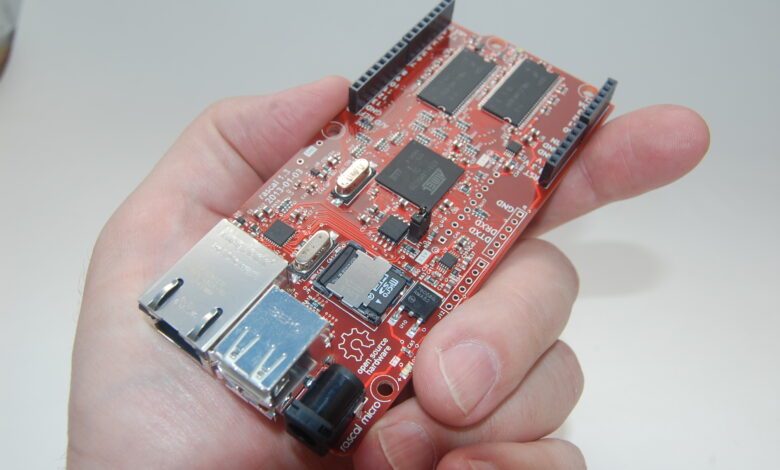The Future of Computing: Single Board Computers Unleashed

1. A Brief History of Single Board Computers
The origins of single board computers can be traced back to the mid-1970s when the first microprocessors were introduced. These early computers were large and expensive, consisting of multiple components such as processors, memory, and input/output devices. However, advances in technology led to the development of single board computers, which integrated all the necessary components onto a single circuit board.
1.1 The Origins of Single Board Computers
The origins of single board computers can be traced back to the Altair 8800, which was released in 1975. The Altair 8800 was one of the first commercially successful personal computers and featured a single circuit board that contained the processor, memory, and input/output devices. This marked the beginning of the single board computer revolution.
Over the years, single board computers have become increasingly powerful and versatile. They have found applications in a wide range of industries, from education and research to industrial automation and Internet of Things (IoT) devices.
1.2 Milestones and Innovations in Single Board Computers
Since the introduction of the Altair 8800, there have been several milestones and innovations in the field of single board computers. One significant milestone was the release of the Raspberry Pi in 2012. The Raspberry Pi was a low-cost, credit card-sized computer that was designed to promote computer science education. Its affordable price and versatility made it widely popular among hobbyists and DIY enthusiasts.
Another notable innovation was the development of single board computers based on ARM architecture. ARM-based single board computers are known for their energy efficiency and low power consumption, making them ideal for IoT applications. Companies like Raspberry Pi, NVIDIA, and Qualcomm have released ARM-based single board computers that offer powerful processing capabilities in a compact form factor.
1.3 Impact of Single Board Computers on the Technology Industry
The advent of single board computers has had a profound impact on the technology industry. They have democratized access to computing power and made it more accessible to a wider audience. This has led to a surge in technological innovation, as individuals and organizations are empowered to create their own solutions.
Single board computers have also played a crucial role in the development of the Internet of Things (IoT). Their small size, low power consumption, and ability to connect to the internet make them ideal for building IoT devices. From smart home automation systems to industrial monitoring and control systems, single board computers have enabled the creation of a connected world.
2. Advantages and Applications of Single Board Computers
Single board computers offer numerous advantages over traditional PCs and laptops. Their compact size, low power consumption, and cost-effectiveness make them ideal for a wide range of applications. Here are some of the key advantages and applications of single board computers:
2.1 Compact Size and Portability
One of the main advantages of single board computers is their small form factor. They are typically the size of a credit card or smaller, making them highly portable. This compact size allows for easy integration into various devices and systems.
For example, single board computers can be used to create portable media players, gaming consoles, and digital signage systems. They can also be integrated into automotive systems, drones, and wearable devices.
2.2 Versatile Uses in Various Industries
Single board computers have found applications in various industries due to their versatility. They can be used in industrial automation systems, home automation systems, medical devices, and scientific research equipment.
In the industrial sector, single board computers are used for monitoring and controlling processes in manufacturing plants. They can collect sensor data, analyze it in real-time, and make decisions based on the data. This improves efficiency, reduces downtime, and increases productivity.
In the healthcare industry, single board computers are used in medical devices such as patient monitors and imaging systems. They enable real-time monitoring of vital signs, data analysis, and remote patient monitoring.
2.3 Cost-Effective Solutions for DIY Enthusiasts
Single board computers are also popular among DIY enthusiasts and hobbyists due to their cost-effectiveness. They offer a low-cost solution for building custom projects and prototypes.
For example, a Raspberry Pi can be used to create a home automation system by connecting sensors, actuators, and a web server. This allows for remote control of various devices in the home, such as lights, appliances, and security systems.
Single board computers are also used in educational settings to teach programming and computer science concepts. Their low cost makes them accessible to schools and students with limited budgets.
3. Future Trends in Single Board Computers
The future of single board computers looks promising, with several trends shaping their development. These trends include advancements in processing power and performance, integration of artificial intelligence and machine learning, and exploration of new form factors and connectivity options.
3.1 Advancements in Processing Power and Performance
Single board computers are becoming increasingly powerful, with the latest models featuring multicore processors, high-speed memory, and advanced graphics capabilities. This allows them to handle demanding tasks such as video processing, machine learning, and virtual reality.
Advancements in processing power and performance will enable single board computers to be used in more computationally intensive applications. For instance, they could be used in autonomous vehicles, robotics, and high-performance computing clusters.
3.2 Integration of Artificial Intelligence and Machine Learning
Artificial intelligence (AI) and machine learning (ML) are rapidly evolving fields that hold great potential for single board computers. The integration of AI and ML capabilities into single board computers will enable them to analyze complex data and make intelligent decisions.
For example, single board computers with AI and ML capabilities can be used for real-time image recognition, natural language processing, and predictive analytics. This opens up new possibilities in fields such as autonomous systems, healthcare diagnostics, and smart cities.
3.3 Exploration of New Form Factors and Connectivity Options
As technology advances, there is an increasing demand for single board computers with new form factors and connectivity options. For instance, there is a growing need for single board computers that can be easily integrated into wearable devices, Internet of Things (IoT) devices, and edge computing systems.
Companies are also exploring the integration of wireless connectivity options such as 5G, Wi-Fi 6, and Bluetooth 5. This will enable single board computers to be used in applications that require high-speed data transfer and low-latency communication.
4. How Single Board Computers are Shaping the Future
Single board computers are playing a significant role in shaping the future of computing and technology. They are empowering the Internet of Things (IoT) and connected devices, revolutionizing education and learning, and enabling innovation and prototyping.
4.1 Empowering IoT and Connected Devices
The Internet of Things (IoT) is rapidly expanding, with billions of connected devices expected to be deployed in the coming years. Single board computers are at the heart of this transformation, providing the computational power and connectivity required for IoT devices.
With single board computers, individuals and organizations can build their own IoT solutions, from smart home automation systems to industrial monitoring and control systems. This empowers users to create custom solutions that meet their specific needs, leading to increased efficiency, improved productivity, and enhanced quality of life.
4.2 Revolutionizing Education and Learning
Single board computers have revolutionized education and learning by making computing more accessible and interactive. They have become a valuable tool for teaching programming, electronics, and computer science concepts.
Teachers can use single board computers in the classroom to engage students and promote hands-on learning. Students can learn coding, electronics, and problem-solving skills by building their own projects using single board computers.
Single board computers also enable remote learning and collaboration. Students can connect with each other and share their projects online, fostering a sense of community and collaboration.
4.3 Enabling Innovation and Prototyping
Single board computers have lowered the barriers to innovation and prototyping. They provide a cost-effective platform for testing ideas, building prototypes, and experimenting with new technologies.
Entrepreneurs and startups can use single board computers to develop and validate their product ideas before investing in expensive hardware and production. This allows them to iterate quickly and bring their innovations to market faster.
In addition, single board computers have sparked a maker movement, where individuals and hobbyists explore their creativity and create unique projects. The availability of open-source software and hardware for single board computers has further fueled innovation and collaboration within the maker community.
In conclusion, single board computers have come a long way since their inception and are poised to shape the future of computing. With advancements in processing power, integration of AI and ML capabilities, and exploration of new form factors and connectivity options, single board computers will continue to drive innovation and empower individuals and industries. Whether it’s powering IoT devices, transforming education, or enabling innovation, single board computers are unleashing the true potential of computing.
Apart from that if you want to know about How Can You Make a Mobile App That Makes Money for Your Company then please visit our Tech Category.


